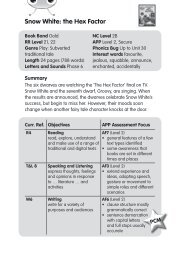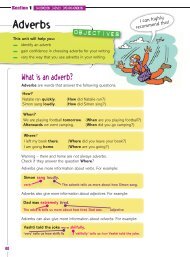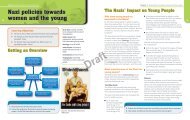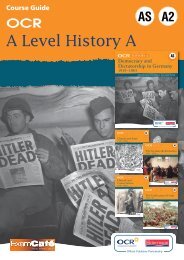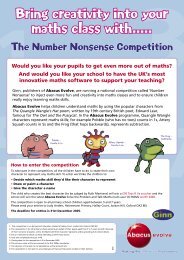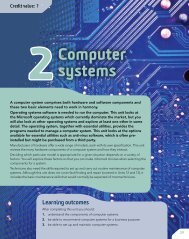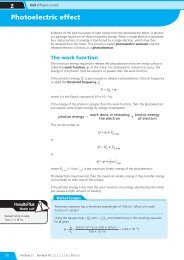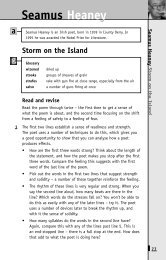Unit 1 Developing effective communication in health and social care
Unit 1 Developing effective communication in health and social care
Unit 1 Developing effective communication in health and social care
You also want an ePaper? Increase the reach of your titles
YUMPU automatically turns print PDFs into web optimized ePapers that Google loves.
BTEC Level 3 National Health <strong>and</strong> Social Care<br />
<strong>Unit</strong> 1 <strong>Develop<strong>in</strong>g</strong> <strong>effective</strong><br />
<strong>communication</strong> <strong>in</strong> <strong>health</strong> <strong>and</strong><br />
<strong>social</strong> <strong>care</strong><br />
<strong>Unit</strong> overview Credits: 10<br />
This m<strong>and</strong>atory unit enables learners to underst<strong>and</strong> <strong>effective</strong> <strong>communication</strong> with<strong>in</strong> <strong>health</strong> or <strong>social</strong> <strong>care</strong><br />
sett<strong>in</strong>gs, some of the many barriers to <strong>effective</strong> <strong>communication</strong> <strong>and</strong> ways to overcome them. Learners will ga<strong>in</strong><br />
the necessary <strong>in</strong>terpersonal skills to communicate with a range of people with<strong>in</strong> the sector <strong>and</strong> will have the<br />
opportunity to identify <strong>and</strong> analyse the <strong>effective</strong>ness of their own <strong>communication</strong> skills.<br />
This is a 10-credit unit <strong>and</strong> can be taught <strong>in</strong> 60 guided learn<strong>in</strong>g hours, with learners also expected to complete<br />
non-supervised <strong>in</strong>dividual study time. This is a m<strong>and</strong>atory unit for all qualifications.<br />
On completion of this unit, learners should:<br />
LO1 Underst<strong>and</strong> <strong>effective</strong> <strong>communication</strong> <strong>and</strong> <strong>in</strong>terpersonal <strong>in</strong>teraction <strong>in</strong> <strong>health</strong> <strong>and</strong> <strong>social</strong> <strong>care</strong><br />
LO2 Underst<strong>and</strong> factors that <strong>in</strong>fluence <strong>communication</strong> <strong>and</strong> <strong>in</strong>terpersonal <strong>in</strong>teraction <strong>in</strong> <strong>health</strong> <strong>and</strong> <strong>social</strong> <strong>care</strong><br />
environments<br />
LO3 Underst<strong>and</strong> ways to overcome barriers <strong>in</strong> a <strong>health</strong> <strong>and</strong> <strong>social</strong> <strong>care</strong> environment<br />
LO4 Be able to communicate <strong>and</strong> <strong>in</strong>teract <strong>effective</strong>ly <strong>in</strong> a <strong>health</strong> or <strong>social</strong> <strong>care</strong> environment<br />
<strong>Unit</strong> contents<br />
The scheme of work for this unit (page 13) l<strong>in</strong>ks to the follow<strong>in</strong>g resources to help you deliver <strong>Unit</strong> 1.<br />
Lesson plan LP<br />
Activity sheet AS1, AS2, AS3, AS4 AS5, AS6, AS7,<br />
AS8, AS9<br />
Stretch <strong>and</strong> support AS1, AS2, AS3, AS4 AS6, AS8, AS9<br />
LO1 LO2 LO3 LO4<br />
AS10, AS11, AS12<br />
Presentation PPT<br />
Video V5 V5<br />
All of these resources, <strong>in</strong>clud<strong>in</strong>g an editable version of the scheme of work, can be found on the accompany<strong>in</strong>g<br />
CD-ROM, as well as answers to the activity sheets <strong>and</strong> Just check<strong>in</strong>g questions <strong>in</strong> the Student Books.<br />
Assessment<br />
This unit is assessed through learners present<strong>in</strong>g evidence that demonstrates they can meet all the learn<strong>in</strong>g<br />
outcomes for the unit. Assignments may be <strong>in</strong> a number of parts <strong>and</strong> will <strong>in</strong>clude reports of learners’ own<br />
<strong>communication</strong> work <strong>in</strong> the role of <strong>health</strong> or <strong>social</strong> <strong>care</strong> worker. Learners must show their underst<strong>and</strong><strong>in</strong>g of<br />
<strong>communication</strong> <strong>in</strong> practice <strong>and</strong> <strong>in</strong>clude an analysis of their own <strong>in</strong>terpersonal skills. Assignments need to <strong>in</strong>clude<br />
one-to-one <strong>in</strong>teraction as well as group <strong>in</strong>teraction, both of which should be analysed, evaluated <strong>and</strong> l<strong>in</strong>ked to<br />
theories. Learners must show evidence of <strong>effective</strong> <strong>in</strong>teraction <strong>in</strong> a <strong>health</strong> <strong>and</strong> <strong>social</strong> <strong>care</strong> environment. This<br />
could <strong>in</strong>volve witness testimony <strong>and</strong> learners’ own reflections, but it is important to ensure that personal<br />
<strong>in</strong>formation about <strong>in</strong>dividuals or staff is not used.<br />
L<strong>in</strong>ks to other units<br />
This unit has l<strong>in</strong>ks with <strong>Unit</strong> 6 Personal <strong>and</strong> professional development <strong>in</strong> <strong>health</strong> <strong>and</strong> <strong>social</strong> <strong>care</strong>, as the skills<br />
<strong>in</strong>volved <strong>in</strong> develop<strong>in</strong>g <strong>and</strong> assess<strong>in</strong>g <strong>communication</strong> skills will be best learnt dur<strong>in</strong>g a period of work<br />
experience.<br />
© Pearson Education Ltd 2010. Copy<strong>in</strong>g permitted for purchas<strong>in</strong>g <strong>in</strong>stitution only. This material is not copyright free. 1
<strong>Unit</strong> 1 <strong>Develop<strong>in</strong>g</strong> <strong>effective</strong> <strong>communication</strong> <strong>in</strong> <strong>health</strong><br />
<strong>and</strong> <strong>social</strong> <strong>care</strong><br />
How to deliver the unit<br />
BTEC Level 3 National Health <strong>and</strong> Social Care<br />
Tutors can <strong>in</strong>troduce learners to this unit through an overview of <strong>communication</strong> skills required <strong>and</strong> the contexts<br />
<strong>in</strong> which they occur. Learners can then work <strong>in</strong> groups to identify these contexts. Extracts of <strong>in</strong>terpersonal<br />
<strong>in</strong>teractions could be presented on DVD/video <strong>and</strong> learners can identify the various forms of <strong>communication</strong><br />
be<strong>in</strong>g demonstrated. Extracts could be purpose-made or simply recorded from TV programmes, such as<br />
Doctors, Casualty, Holby City, House or Trauma. Reality programmes such as Jeremy Kyle can be useful for<br />
examples of mis<strong>communication</strong>.<br />
Guest speakers can enhance learn<strong>in</strong>g significantly by allow<strong>in</strong>g learners to experience the various forms of<br />
<strong>communication</strong> <strong>and</strong> to practise their own skills (AS2, AS4). Guests could <strong>in</strong>clude signers or Makaton users,<br />
therapists, people from different cultures <strong>and</strong> people with visual or hear<strong>in</strong>g impairments.<br />
In small groups learners can research each form of <strong>communication</strong> <strong>and</strong> present their f<strong>in</strong>d<strong>in</strong>gs as a presentation.<br />
Learners could carry out a similar research project to help them appreciate the positive <strong>and</strong> negative effects of<br />
<strong>communication</strong> <strong>and</strong> barriers, as <strong>in</strong> AS8 <strong>and</strong> AS9. Tutors should encourage learners to produce posters or<br />
leaflets to be displayed as a rem<strong>in</strong>der of the importance of good <strong>communication</strong> skills.<br />
The unit should be presented <strong>in</strong> an <strong>in</strong>teractive way, with learners tak<strong>in</strong>g part <strong>in</strong> as much role play <strong>and</strong> discussion<br />
as possible – activities some learners f<strong>in</strong>d easier than others. Tutors should offer support wherever needed,<br />
encourag<strong>in</strong>g quiet or less confident learners to participate <strong>in</strong> group discussions. The more vocal members of the<br />
group will need support to allow others to be heard. This may be particularly relevant when role play<strong>in</strong>g<br />
‘assertiveness’ <strong>and</strong> tutors should be prepared to challenge ‘aggressive’ responses. Record<strong>in</strong>g or video<strong>in</strong>g<br />
discussions will provide learners with useful feedback <strong>in</strong> order to evaluate their own skills.<br />
Useful resources<br />
Books<br />
Bateman, N. (2000) Advocacy Skills for Health <strong>and</strong> Social Care Professionals, London, Jessica K<strong>in</strong>gsley.<br />
Burnard, P. (1992) Communicate! Communication Skills Guide for Health Care Workers, London, Hodder<br />
Arnold.<br />
Moss, B. (2007) Communication Skills for Health <strong>and</strong> Social Care, London, Sage Publications.<br />
Stretch, B. <strong>and</strong> Whitehouse, M. (2010) BTEC National Health <strong>and</strong> Social Care Book 2, Oxford, Pearson.<br />
Websites<br />
East Anglia Communications Skills Cascade<br />
Resources to promote <strong>and</strong> support the teach<strong>in</strong>g of <strong>communication</strong> skills <strong>in</strong> <strong>health</strong> <strong>care</strong><br />
http://www.skillscascade.com/<br />
National Institute for Health <strong>and</strong> Cl<strong>in</strong>ical Excellence<br />
Provides guidance on promot<strong>in</strong>g good <strong>health</strong> <strong>and</strong> prevent<strong>in</strong>g <strong>and</strong> treat<strong>in</strong>g ill <strong>health</strong><br />
http://www.nice.org/uk/<br />
British Sign Language<br />
http://www.britishsignlanguage.com<br />
The Makaton Charity<br />
http://www.makaton.org/<br />
2 © Pearson Education Ltd 2010. Copy<strong>in</strong>g permitted for purchas<strong>in</strong>g <strong>in</strong>stitution only. This material is not copyright free.
© Pearson Education Ltd 2010. Copy<strong>in</strong>g permitted for purchas<strong>in</strong>g <strong>in</strong>stitution only. This material is not copyright free.<br />
1<br />
Scheme of work<br />
<strong>Unit</strong> 1 <strong>Develop<strong>in</strong>g</strong> <strong>effective</strong> <strong>communication</strong> <strong>in</strong> <strong>health</strong> <strong>and</strong> <strong>social</strong> <strong>care</strong><br />
Broad aim: To underst<strong>and</strong> <strong>effective</strong> <strong>communication</strong>, barriers to this <strong>and</strong> ways to overcome these.<br />
Tutor(s):<br />
PPT= Presentation<br />
SB1/2 = Student Book 1 or 2<br />
AS = Activity sheet<br />
V = Video<br />
NS = Non-supervised <strong>in</strong>dividual study time<br />
R = Research<br />
Academic year:<br />
Number of weeks: 20<br />
Duration of session: 3 hour blocks*<br />
Guided learn<strong>in</strong>g hours: 60 hours<br />
Credits: 10<br />
*3 hour blocks may be delivered over 3 sessions<br />
Week Outcome/topic Tutor activity Learner activity Resources Assessment <strong>and</strong><br />
PLTS <strong>and</strong> Functional<br />
Skills<br />
1 LO1:<br />
Underst<strong>and</strong><br />
<strong>effective</strong><br />
<strong>communication</strong><br />
<strong>and</strong><br />
<strong>in</strong>terpersonal<br />
<strong>in</strong>teraction <strong>in</strong><br />
<strong>health</strong> <strong>and</strong><br />
<strong>social</strong> <strong>care</strong><br />
2 LO1: Forms of<br />
<strong>communication</strong><br />
3 LO1: Types of<br />
<strong>in</strong>terpersonal<br />
<strong>in</strong>teraction<br />
Introduce specification <strong>and</strong> lead<br />
discussions about contexts<br />
Support <strong>in</strong>dividual learners where<br />
necessary<br />
Focus learners on the ways they<br />
communicate<br />
Arrange guest speakers, e.g.<br />
signers or practitioners <strong>in</strong> art or<br />
music therapy<br />
Lead discussions <strong>and</strong> activities<br />
Lesson plan <strong>in</strong>cluded<br />
Read through the specification <strong>and</strong><br />
identify different forms of<br />
<strong>communication</strong> <strong>and</strong> their contexts<br />
Small group discussion <strong>and</strong><br />
feedback: the role of<br />
<strong>communication</strong> <strong>in</strong>clud<strong>in</strong>g impact on<br />
<strong>in</strong>dividuals<br />
SB activities <strong>and</strong> case studies<br />
SB Activity<br />
NS – Learners carry out workrelated<br />
observation/research <strong>in</strong>to<br />
forms of <strong>communication</strong><br />
Learners complete AS1, AS2 <strong>and</strong><br />
AS3<br />
SB case studies<br />
Group activities<br />
V5 – T<strong>in</strong>a talks to Mary<br />
SB1 Amber p.7, Karen p.8,<br />
Daniel, p.3<br />
English: Speak<strong>in</strong>g <strong>and</strong><br />
listen<strong>in</strong>g<br />
SB1 p.9 IE, SM<br />
English: Speak<strong>in</strong>g <strong>and</strong><br />
listen<strong>in</strong>g<br />
AS1 Types of <strong>in</strong>terpersonal<br />
<strong>in</strong>teraction<br />
AS2 Assess<strong>in</strong>g your own<br />
skills<br />
AS3 Non-verbal<br />
<strong>communication</strong>: Personal<br />
space<br />
SB1 p.10<br />
IE, CT, RL<br />
English: Speak<strong>in</strong>g <strong>and</strong><br />
listen<strong>in</strong>g<br />
Stretch <strong>and</strong><br />
support<br />
Peer support <strong>in</strong><br />
mixed ability groups<br />
Mixed ability groups<br />
for peer support<br />
Stretch – AS1, AS2<br />
<strong>and</strong> AS3 stretch<br />
sections<br />
Peer support for less<br />
able learners<br />
BTEC Level 3 National Health <strong>and</strong> Social Care <strong>Unit</strong> 1 <strong>Develop<strong>in</strong>g</strong> <strong>effective</strong> <strong>communication</strong> <strong>in</strong> <strong>health</strong><br />
<strong>and</strong> <strong>social</strong> <strong>care</strong>
2<br />
© Pearson Education Ltd 2010. Copy<strong>in</strong>g permitted for purchas<strong>in</strong>g <strong>in</strong>stitution only. This material is not copyright free.<br />
Week Outcome/topic Tutor activity Learner activity Resources Assessment <strong>and</strong><br />
PLTS <strong>and</strong> Functional<br />
Skills<br />
4 LO1:<br />
Communication<br />
<strong>and</strong> language<br />
needs <strong>and</strong><br />
preferences<br />
5 Preparation for<br />
assignment<br />
6 Assignment 1:<br />
The role of<br />
<strong>communication</strong><br />
<strong>and</strong><br />
<strong>in</strong>terpersonal<br />
<strong>in</strong>teraction <strong>in</strong><br />
<strong>health</strong> <strong>and</strong><br />
<strong>social</strong> <strong>care</strong><br />
7 LO2:<br />
Underst<strong>and</strong><br />
factors that<br />
<strong>in</strong>fluence<br />
<strong>communication</strong><br />
<strong>and</strong><br />
<strong>in</strong>terpersonal<br />
<strong>in</strong>teraction <strong>in</strong><br />
<strong>health</strong> <strong>and</strong><br />
<strong>social</strong> <strong>care</strong><br />
environments<br />
Theories of<br />
<strong>communication</strong><br />
8 LO2:<br />
Environment<br />
Arrange for taster session with<br />
professional<br />
Encourage discussion around<br />
<strong>in</strong>dividual preferences<br />
Introduce learners to selfassessment/evaluation<br />
of skills<br />
Provide sensitive feedback to<br />
learners’ own assessments<br />
Ensure learners have planned <strong>and</strong><br />
discussed their <strong>in</strong>teraction with<br />
workplace supervisor<br />
Ensure learners underst<strong>and</strong> <strong>and</strong><br />
follow the guidel<strong>in</strong>es for the<br />
assessment task<br />
Introduce learners to the<br />
<strong>communication</strong> cycle <strong>and</strong><br />
theory/stages of group <strong>in</strong>teraction<br />
Lead the role play; encourage<br />
reflection <strong>and</strong> l<strong>in</strong>ks to theories<br />
Lead whole group discussions<br />
Prepare record<strong>in</strong>g sheets<br />
Ensure group<strong>in</strong>gs are balanced<br />
R – Identify methods of<br />
<strong>communication</strong> such as British Sign<br />
Language (BSL), Makaton, etc.<br />
SB Activity<br />
Learners complete AS4 to assess<br />
non-verbal skills<br />
NS – Learners communicate <strong>in</strong> the<br />
workplace <strong>and</strong> l<strong>in</strong>k this to the<br />
theory, e.g. through a log with<br />
examples of <strong>communication</strong> <strong>and</strong><br />
<strong>in</strong>terpersonal <strong>in</strong>teractions<br />
Learners complete AS5, AS6 <strong>and</strong><br />
AS7<br />
Learners carry out role<br />
play/reflections with reference to<br />
stages of <strong>communication</strong><br />
Presentations to group<br />
SB activity <strong>and</strong> case study<br />
V Workspace case study <strong>and</strong> video<br />
NS – Observations <strong>in</strong> the<br />
workplace<br />
Learners discuss contexts for<br />
group <strong>in</strong>teraction <strong>and</strong> participate <strong>in</strong><br />
different types of group <strong>in</strong>teraction:<br />
record<strong>in</strong>g, reflect<strong>in</strong>g <strong>and</strong> feedback<br />
SB activity<br />
A taster session for British<br />
Sign Language <strong>and</strong>/or<br />
Makaton may encourage<br />
learners to develop these<br />
skills further.<br />
SB1 p.14<br />
AS4 Assess your own nonverbal<br />
skills<br />
IE, RL<br />
ICT: Br<strong>in</strong>g together<br />
<strong>in</strong>formation to suit<br />
content <strong>and</strong> purpose<br />
English: Speak<strong>in</strong>g <strong>and</strong><br />
listen<strong>in</strong>g<br />
RL<br />
English: Speak<strong>in</strong>g <strong>and</strong><br />
listen<strong>in</strong>g<br />
Template to prepare log P1, M1<br />
IE, SM<br />
English: Speak<strong>in</strong>g <strong>and</strong><br />
listen<strong>in</strong>g<br />
AS5 Factors that <strong>in</strong>fluence<br />
<strong>communication</strong> <strong>and</strong><br />
<strong>in</strong>terpersonal <strong>in</strong>teraction<br />
AS6 Factors that <strong>in</strong>fluence<br />
<strong>communication</strong><br />
AS7 The <strong>communication</strong><br />
cycle<br />
SB1 p.19<br />
V5<br />
Record<strong>in</strong>g sheets<br />
SB1 p.21<br />
IE<br />
English: Speak<strong>in</strong>g <strong>and</strong><br />
listen<strong>in</strong>g<br />
IE, CT<br />
English: Speak<strong>in</strong>g <strong>and</strong><br />
listen<strong>in</strong>g, Writ<strong>in</strong>g<br />
Stretch <strong>and</strong><br />
support<br />
Individual support as<br />
necessary to carry<br />
out research<br />
Stretch – AS4<br />
stretch section<br />
Careful guidance<br />
needed to protect<br />
vulnerable learners<br />
Stretch – AS6<br />
stretch section<br />
Support may be<br />
needed to protect<br />
more vulnerable<br />
learners dur<strong>in</strong>g role<br />
play<br />
Mixed ability groups<br />
<strong>Unit</strong> 1 <strong>Develop<strong>in</strong>g</strong> <strong>effective</strong> <strong>communication</strong> <strong>in</strong> <strong>health</strong><br />
<strong>and</strong> <strong>social</strong> <strong>care</strong><br />
BTEC Level 3 National Health <strong>and</strong> Social Care
© Pearson Education Ltd 2010. Copy<strong>in</strong>g permitted for purchas<strong>in</strong>g <strong>in</strong>stitution only. This material is not copyright free.<br />
3<br />
Week Outcome/topic Tutor activity Learner activity Resources Assessment <strong>and</strong><br />
PLTS <strong>and</strong> Functional<br />
Skills<br />
9 LO2: Barriers Introduce a range of factors that<br />
affect <strong>communication</strong><br />
Invite a suitable guest speaker to<br />
provide <strong>in</strong>sight <strong>in</strong>to cultural<br />
variations <strong>in</strong> verbal <strong>and</strong> non-verbal<br />
<strong>communication</strong><br />
10 Putt<strong>in</strong>g LO2 <strong>in</strong>to<br />
practice<br />
Review learn<strong>in</strong>g<br />
11 Assignment 2:<br />
Underst<strong>and</strong><strong>in</strong>g<br />
<strong>effective</strong><br />
<strong>communication</strong><br />
<strong>and</strong><br />
<strong>in</strong>terpersonal<br />
skills<br />
12 LO3:<br />
Underst<strong>and</strong><br />
ways to<br />
overcome<br />
barriers <strong>in</strong> a<br />
<strong>health</strong> <strong>and</strong><br />
<strong>social</strong> <strong>care</strong><br />
environment<br />
Communication<br />
<strong>and</strong><br />
<strong>in</strong>terpersonal<br />
<strong>in</strong>teraction<br />
13 LO3: Aids to<br />
<strong>communication</strong><br />
Provide a summary to<br />
<strong>communication</strong> barriers, ways to<br />
overcome these <strong>and</strong> skills required<br />
Lead role plays<br />
Introduce the assignment <strong>and</strong><br />
ensure learners are familiar with<br />
the assessment criteria<br />
Discuss assertive, aggressive <strong>and</strong><br />
submissive behaviour<br />
Introduce complex issues/cop<strong>in</strong>g<br />
skills<br />
Provide a variety of aids to<br />
<strong>communication</strong> for learners to<br />
explore<br />
Lead role play<br />
R – Learners carry out group<br />
research <strong>in</strong>to positive <strong>and</strong> negative<br />
factors affect<strong>in</strong>g <strong>communication</strong><br />
NS – Learners create a poster of<br />
barriers to <strong>communication</strong><br />
SB case studies<br />
Learners complete AS8 <strong>and</strong> AS9<br />
Learners use role play <strong>and</strong><br />
feedback to practise<br />
<strong>communication</strong> us<strong>in</strong>g a counsell<strong>in</strong>g<br />
skills tra<strong>in</strong><strong>in</strong>g format<br />
Learners cover one-to-one <strong>and</strong><br />
group <strong>communication</strong> <strong>and</strong><br />
<strong>in</strong>terpersonal <strong>in</strong>teraction, <strong>in</strong>clud<strong>in</strong>g<br />
factors <strong>and</strong> strategies used to<br />
assist <strong>effective</strong> <strong>in</strong>teractions<br />
SB activities<br />
Learners practise assertiveness<br />
skills through role play <strong>and</strong><br />
complete AS10 <strong>and</strong> AS11<br />
SB activities <strong>and</strong> case studies<br />
Learners role play human aids, e.g.<br />
the part of an advocate<br />
SB Activity <strong>and</strong> case studies<br />
SB1 p.23, 25, 27 IE, CT<br />
English: Speak<strong>in</strong>g <strong>and</strong><br />
listen<strong>in</strong>g<br />
ICT: Br<strong>in</strong>g together<br />
<strong>in</strong>formation<br />
AS8 Barriers to<br />
<strong>communication</strong><br />
AS9 Overcom<strong>in</strong>g<br />
<strong>communication</strong> barriers<br />
Internet access<br />
IE, CT<br />
English: Speak<strong>in</strong>g <strong>and</strong><br />
listen<strong>in</strong>g<br />
SB1 p.21, 28, 39 P2, P3, P4, M2, D1<br />
IE, CT<br />
English: Speak<strong>in</strong>g <strong>and</strong><br />
listen<strong>in</strong>g<br />
ICT: Record<strong>in</strong>g<br />
AS10 Assertiveness<br />
AS11 Assertive behaviour<br />
SB1 p.30<br />
Technological aids<br />
SB1 p.37<br />
IE, CT<br />
English: Speak<strong>in</strong>g <strong>and</strong><br />
listen<strong>in</strong>g<br />
IE, RL<br />
English: Speak<strong>in</strong>g <strong>and</strong><br />
listen<strong>in</strong>g<br />
ICT: Br<strong>in</strong>g together<br />
<strong>in</strong>formation<br />
Stretch <strong>and</strong><br />
support<br />
Mixed ability groups;<br />
The more able could<br />
research cultural<br />
variations<br />
Stretch – AS8 <strong>and</strong><br />
AS9 stretch sections<br />
Encourage less<br />
assertive learners<br />
<strong>and</strong> guide more<br />
aggressive learners<br />
to support others<br />
Mixed ability groups<br />
to support each<br />
other on research<br />
BTEC Level 3 National Health <strong>and</strong> Social Care <strong>Unit</strong> 1 <strong>Develop<strong>in</strong>g</strong> <strong>effective</strong> <strong>communication</strong> <strong>in</strong> <strong>health</strong><br />
<strong>and</strong> <strong>social</strong> <strong>care</strong>
4<br />
© Pearson Education Ltd 2010. Copy<strong>in</strong>g permitted for purchas<strong>in</strong>g <strong>in</strong>stitution only. This material is not copyright free.<br />
Week Outcome/topic Tutor activity Learner activity Resources Assessment <strong>and</strong><br />
PLTS <strong>and</strong> Functional<br />
Skills<br />
14 Assignment 3:<br />
One-to-one<br />
<strong>in</strong>terpersonal<br />
<strong>in</strong>teraction <strong>and</strong><br />
review<br />
Ensure learners have planned <strong>and</strong><br />
discussed their <strong>in</strong>teraction with a<br />
workplace supervisor<br />
Ensure learners underst<strong>and</strong> <strong>and</strong><br />
follow the guidel<strong>in</strong>es for the<br />
assessment task<br />
15 Review Go through the presentation <strong>and</strong><br />
the theory hidden underneath the<br />
pictures (The Communication<br />
Cycle)<br />
16 LO4: Be able to<br />
communicate<br />
<strong>and</strong> <strong>in</strong>teract<br />
<strong>effective</strong>ly <strong>in</strong> a<br />
<strong>health</strong> or <strong>social</strong><br />
<strong>care</strong><br />
environment<br />
17 LO4:<br />
Communication<br />
skills<br />
18 LO4:<br />
Effectiveness<br />
19 Assignment 4:<br />
Group<br />
<strong>in</strong>teraction <strong>and</strong><br />
reflection<br />
20 LO1, LO2, LO3,<br />
LO4<br />
Provide opportunities for learners<br />
to practise their skills<br />
Ensure arrangements for<br />
<strong>in</strong>teractions with<strong>in</strong> the workplace<br />
are discussed <strong>and</strong> agreed with<br />
tutor <strong>and</strong> supervisors<br />
Provide support <strong>and</strong> feedback to<br />
improve learners’ skills <strong>in</strong><br />
preparation for assessment<br />
Provide support to improve<br />
learners’ skills <strong>in</strong> <strong>in</strong>teraction <strong>and</strong><br />
writ<strong>in</strong>g up evidence<br />
Provide time <strong>and</strong> support for<br />
learners to complete their<br />
assignments<br />
Learners provide evidence of<br />
<strong>in</strong>teraction with an <strong>in</strong>dividual <strong>in</strong> a<br />
<strong>health</strong> <strong>and</strong> <strong>social</strong> <strong>care</strong> context<br />
SB Assessment activity 1.5<br />
PPT<br />
Learners work <strong>in</strong> groups to answer<br />
questions on PPT <strong>and</strong> guess the<br />
hidden theory<br />
Learners use AS12 for revision<br />
Learners can practise their<br />
<strong>communication</strong> <strong>and</strong> personal<br />
<strong>in</strong>teractive skills <strong>in</strong> preparation for<br />
assessed <strong>in</strong>teractions<br />
SB Activity<br />
NS – F<strong>in</strong>ish chapter 1 of SB1<br />
NS – Learners carry out<br />
<strong>in</strong>teractions <strong>and</strong> record the<br />
outcomes<br />
NS – Learners can record<br />
<strong>in</strong>teractions to support the<br />
review<strong>in</strong>g process <strong>and</strong> receive<br />
feedback from peers <strong>and</strong> tutors<br />
Learners provide evidence of group<br />
<strong>in</strong>teraction <strong>in</strong> a <strong>health</strong> <strong>and</strong> <strong>social</strong><br />
<strong>care</strong> context as a review of skills<br />
SB: Assessment activity 1.6<br />
Learners complete <strong>and</strong> check<br />
assignments aga<strong>in</strong>st the<br />
assessment criteria<br />
SB1 p.41<br />
Log/witness form<br />
AS12 Key terms<br />
PPT<br />
P5 (part M3 <strong>and</strong> part<br />
D2)<br />
CT, RL, SM<br />
English: Speak<strong>in</strong>g <strong>and</strong><br />
listen<strong>in</strong>g<br />
ICT: Record<strong>in</strong>g<br />
English: Speak<strong>in</strong>g <strong>and</strong><br />
listen<strong>in</strong>g<br />
SB1 p.38 IE, SM<br />
English: Speak<strong>in</strong>g <strong>and</strong><br />
listen<strong>in</strong>g<br />
SB1 for reference IE, SM<br />
English: Speak<strong>in</strong>g <strong>and</strong><br />
listen<strong>in</strong>g<br />
ICT: Record<strong>in</strong>g<br />
SB1 for reference IE, SM<br />
English: Speak<strong>in</strong>g <strong>and</strong><br />
listen<strong>in</strong>g<br />
ICT: Record<strong>in</strong>g<br />
SB1 p.42 P6, M3, D2<br />
CT, RL, SM<br />
English: Speak<strong>in</strong>g <strong>and</strong><br />
listen<strong>in</strong>g.<br />
ICT: Record<strong>in</strong>g<br />
SB for reference English: Speak<strong>in</strong>g <strong>and</strong><br />
listen<strong>in</strong>g<br />
ICT: Record<strong>in</strong>g<br />
Stretch <strong>and</strong><br />
support<br />
Mixed ability groups<br />
Support learners as<br />
necessary through<br />
sensitive feedback<br />
Support may be<br />
needed for less able<br />
learners<br />
Support <strong>in</strong>dividual<br />
learners as needed<br />
Individual support as<br />
necessary to<br />
encourage highest<br />
atta<strong>in</strong>ment<br />
<strong>Unit</strong> 1 <strong>Develop<strong>in</strong>g</strong> <strong>effective</strong> <strong>communication</strong> <strong>in</strong> <strong>health</strong><br />
<strong>and</strong> <strong>social</strong> <strong>care</strong><br />
BTEC Level 3 National Health <strong>and</strong> Social Care
© Pearson Education Ltd 2010. Copy<strong>in</strong>g permitted for purchas<strong>in</strong>g <strong>in</strong>stitution only. This material is not copyright free.<br />
1<br />
Lesson plan – Week 3<br />
Aim<br />
To <strong>in</strong>troduce learners to different types of <strong>in</strong>terpersonal <strong>in</strong>teraction, e.g. speech, language (first language, dialect, slang, jargon), non-verbal <strong>communication</strong> (posture, facial expression,<br />
touch, silence, proximity, reflective listen<strong>in</strong>g)<br />
SB1/2 = Student Book 1 or 2<br />
PPT = Presentation<br />
AS = Activity sheet<br />
V = Video<br />
This is a 60-m<strong>in</strong>ute lesson.<br />
Learn<strong>in</strong>g objectives<br />
● All learners will underst<strong>and</strong> <strong>effective</strong> <strong>communication</strong> <strong>and</strong> <strong>in</strong>terpersonal <strong>in</strong>teraction by participat<strong>in</strong>g <strong>in</strong> activities<br />
● All learners will describe each term<br />
● All learners will reflect upon their own <strong>communication</strong> skills <strong>and</strong> make adaptations as necessary<br />
● Most learners will read the relative chapter <strong>in</strong> SB1 <strong>and</strong> make notes on the different types of <strong>in</strong>terpersonal <strong>in</strong>teraction<br />
● Some learners will research further <strong>in</strong>to areas such as non-verbal <strong>communication</strong><br />
Tim<strong>in</strong>g/<br />
content<br />
5 m<strong>in</strong><br />
Welcome<br />
Tutor activity Learner activity Resources Individualised activity/<br />
differentiation<br />
Welcome to the session <strong>and</strong><br />
aims of the lesson written on<br />
the board<br />
Health <strong>and</strong> safety check<br />
Every Child Matters check<br />
Register<br />
5 m<strong>in</strong> H<strong>and</strong> out packs of cards <strong>and</strong><br />
expla<strong>in</strong> the task; each card<br />
should conta<strong>in</strong> a symbol that<br />
learners will not <strong>in</strong>stantly<br />
recognise<br />
5 m<strong>in</strong> Lead feedback <strong>and</strong> discussion;<br />
record responses on board<br />
5 m<strong>in</strong> Introduce the importance of<br />
listen<strong>in</strong>g <strong>and</strong> the case study<br />
Learners settle <strong>and</strong> read aims Whiteboard/<strong>in</strong>teractive<br />
whiteboard/pen<br />
PC<br />
Learners work <strong>in</strong> pairs, sitt<strong>in</strong>g<br />
back to back, <strong>and</strong> take it turns<br />
to pull out a card <strong>and</strong> describe<br />
the picture to their partner, who<br />
draws the picture<br />
Learners discuss the difficulties<br />
<strong>in</strong>volved <strong>in</strong> the previous<br />
exercise<br />
Is speech alone enough to<br />
communicate? What else is<br />
<strong>in</strong>volved?<br />
Learners read SB case study<br />
<strong>and</strong> answer questions on page<br />
14<br />
Packs of 6+ cards <strong>in</strong> envelopes<br />
Paper <strong>and</strong> pens/<strong>in</strong>dividual<br />
whiteboards <strong>and</strong> pens<br />
Whiteboard/<strong>in</strong>teractive<br />
whiteboard/pen<br />
SB1 p.14<br />
Learner pairs may be<br />
deliberately balanced or<br />
arranged accord<strong>in</strong>g to stretch<br />
<strong>and</strong> support needs<br />
Quiet learners persuaded to<br />
communicate ideas<br />
PLTS Functional<br />
Skills<br />
IE, CT<br />
RL English:<br />
Speak<strong>in</strong>g <strong>and</strong><br />
listen<strong>in</strong>g<br />
BTEC Level 3 National Health <strong>and</strong> Social Care <strong>Unit</strong> 1 <strong>Develop<strong>in</strong>g</strong> <strong>effective</strong> <strong>communication</strong> <strong>in</strong> <strong>health</strong><br />
<strong>and</strong> <strong>social</strong> <strong>care</strong>
2<br />
© Pearson Education Ltd 2010. Copy<strong>in</strong>g permitted for purchas<strong>in</strong>g <strong>in</strong>stitution only. This material is not copyright free.<br />
Tim<strong>in</strong>g/<br />
content<br />
Tutor activity Learner activity Resources Individualised activity/<br />
differentiation<br />
10 m<strong>in</strong> Give out AS1 Types of<br />
<strong>in</strong>terpersonal <strong>in</strong>teraction<br />
10 m<strong>in</strong> Direct learners to SB1 case<br />
study: Professional jargon<br />
5 m<strong>in</strong> Expla<strong>in</strong> the ‘proximity exercise’<br />
<strong>and</strong> ask students to complete<br />
the exercise<br />
After 2 m<strong>in</strong>utes take feedback:<br />
differences between friends or<br />
learners who do not know each<br />
other well<br />
10 m<strong>in</strong> H<strong>and</strong> out AS2 Assess<strong>in</strong>g your<br />
own skills<br />
5 m<strong>in</strong><br />
Plenary<br />
Consider us<strong>in</strong>g <strong>in</strong>dividual<br />
question<strong>in</strong>g to check<br />
underst<strong>and</strong><strong>in</strong>g<br />
Encourage learners to read the<br />
whole of Chapter 1 <strong>in</strong> SB1 <strong>and</strong><br />
make notes<br />
Learners complete activity sheet AS1 Types of <strong>in</strong>terpersonal<br />
<strong>in</strong>teraction<br />
Learners read <strong>and</strong> answer<br />
questions<br />
Learners work <strong>in</strong> pairs. One<br />
approaches the other until they<br />
say stop (when they feel<br />
uncomfortable). Measure toe to<br />
toe distance. Swap round to<br />
<strong>in</strong>clude same/different genders,<br />
sizes or ages.<br />
PLTS Functional<br />
Skills<br />
Stretch – AS1 stretch section IE, SM English:<br />
Speak<strong>in</strong>g <strong>and</strong><br />
listen<strong>in</strong>g<br />
SB1 p.10 More able learners can check<br />
the use of jargon <strong>in</strong> a <strong>health</strong> <strong>and</strong><br />
<strong>social</strong> <strong>care</strong> sett<strong>in</strong>g<br />
Tape measure<br />
Paper <strong>and</strong> pen<br />
IE, CT<br />
IE, CT, SM<br />
Learners complete activity sheet AS2 Assess<strong>in</strong>g your own skills Stretch – AS2 stretch section IE, CT, SM English:<br />
Speak<strong>in</strong>g <strong>and</strong><br />
listen<strong>in</strong>g<br />
Learners read SB <strong>and</strong> make<br />
notes to check underst<strong>and</strong><strong>in</strong>g of<br />
terms<br />
Whiteboard or PPT of all the<br />
terms used <strong>in</strong> this section<br />
<strong>Unit</strong> 1 <strong>Develop<strong>in</strong>g</strong> <strong>effective</strong> <strong>communication</strong> <strong>in</strong> <strong>health</strong><br />
<strong>and</strong> <strong>social</strong> <strong>care</strong><br />
BTEC Level 3 National Health <strong>and</strong> Social Care
BTEC Level 3 National Health <strong>and</strong> Social Care<br />
<strong>Unit</strong> 1 <strong>Develop<strong>in</strong>g</strong> <strong>effective</strong> <strong>communication</strong> <strong>in</strong> <strong>health</strong><br />
<strong>and</strong> <strong>social</strong> <strong>care</strong><br />
Types of <strong>in</strong>terpersonal <strong>in</strong>teraction<br />
Test your <strong>communication</strong> skills. Look at the faces below <strong>and</strong> decide what each character is feel<strong>in</strong>g. Compare<br />
your answers to those given by other members of the group. Do you agree?<br />
Mirror<strong>in</strong>g, or reflective listen<strong>in</strong>g, is an <strong>effective</strong> way to show people that you are really listen<strong>in</strong>g.<br />
With a partner or friend practise reflective listen<strong>in</strong>g. One person speaks <strong>and</strong> the other must mirror their actions<br />
<strong>and</strong> their words. Do not make it obvious that you are do<strong>in</strong>g this. You can say th<strong>in</strong>gs like:<br />
‘So are you say<strong>in</strong>g that…?’<br />
‘Have I heard you correctly? Did you say…?’<br />
‘You’re look<strong>in</strong>g very sad. Do you feel sad?’<br />
Ask your partner for feedback. Were you be<strong>in</strong>g too obvious? Did you put your partner at ease?<br />
Did they feel that they wanted to open up <strong>and</strong> share more with you?<br />
Slang is language outside conventional usage. Use the table below to decide the mean<strong>in</strong>g of each of the words<br />
<strong>and</strong> then compare your answers to your friend’s answers.<br />
Slang word Your <strong>in</strong>terpretation Your friend’s <strong>in</strong>terpretation<br />
Sad<br />
Cushy<br />
Ace<br />
Sick<br />
Savvy<br />
1. Th<strong>in</strong>k of a word or two of your own <strong>and</strong> ask your partner for their <strong>in</strong>terpretation of it.<br />
2. Did you both agree on all the words? If not, why do you th<strong>in</strong>k you had different answers?<br />
3. Why do you th<strong>in</strong>k it is important not to use slang with<strong>in</strong> <strong>health</strong> <strong>and</strong> <strong>social</strong> <strong>care</strong> sett<strong>in</strong>gs?<br />
4. Ask parents for their <strong>in</strong>terpretation of the above words. Why do you th<strong>in</strong>k the mean<strong>in</strong>g of some words<br />
changes over time?<br />
Stretch<br />
AS1<br />
Visit the website below <strong>and</strong> test your ability to read emotions <strong>in</strong> people’s eyes.<br />
http://glennrowe.net/BaronCohen/Faces/EyesTest.aspx<br />
© Pearson Education Ltd 2010. Copy<strong>in</strong>g permitted for purchas<strong>in</strong>g <strong>in</strong>stitution only. This material is not copyright free. 1
<strong>Unit</strong> 1 <strong>Develop<strong>in</strong>g</strong> <strong>effective</strong> <strong>communication</strong> <strong>in</strong> <strong>health</strong><br />
<strong>and</strong> <strong>social</strong> <strong>care</strong><br />
Assess<strong>in</strong>g your own skills<br />
BTEC Level 3 National Health <strong>and</strong> Social Care<br />
In groups of three carry out a one-to-one discussion about the course content <strong>and</strong> thoughts on what you will<br />
learn. The third member of the group observes the <strong>in</strong>teraction, records the <strong>communication</strong> skills of one of the<br />
participants <strong>and</strong> then gives feedback to that participant <strong>in</strong> preparation for <strong>in</strong>teractions with<strong>in</strong> the workplace.<br />
Rotate the roles until everyone has observed <strong>and</strong> been assessed.<br />
Communication skills Notes<br />
Listen<strong>in</strong>g<br />
Respond<strong>in</strong>g<br />
Tone<br />
Pace<br />
Language<br />
Appropriate environment<br />
Proximity<br />
Clarify<strong>in</strong>g or repeat<strong>in</strong>g<br />
Question<strong>in</strong>g<br />
Respond<strong>in</strong>g to difficult<br />
situations<br />
Stretch<br />
AS2<br />
You may also wish to video your <strong>in</strong>teraction <strong>and</strong> assess your own skills.<br />
1 © Pearson Education Ltd 2010. Copy<strong>in</strong>g permitted for purchas<strong>in</strong>g <strong>in</strong>stitution only. This material is not copyright free.
BTEC Level 3 National Health <strong>and</strong> Social Care<br />
Non-verbal <strong>communication</strong>:<br />
Personal space<br />
There are different expectations about personal space.<br />
Fill <strong>in</strong> the chart below by consider<strong>in</strong>g who you would allow to enter each area.<br />
In small groups discuss your answers to the follow<strong>in</strong>g questions:<br />
1. If an elderly client was feel<strong>in</strong>g upset, would you give them a hug?<br />
<strong>Unit</strong> 1 <strong>Develop<strong>in</strong>g</strong> <strong>effective</strong> <strong>communication</strong> <strong>in</strong> <strong>health</strong><br />
<strong>and</strong> <strong>social</strong> <strong>care</strong><br />
2. You are <strong>in</strong> a meet<strong>in</strong>g with your team leader <strong>and</strong> a client you support. Where would you sit <strong>in</strong> relation to each<br />
other?<br />
3. A young child you are look<strong>in</strong>g after falls over <strong>and</strong> scrapes their knee. How would you respond?<br />
4. An adult with learn<strong>in</strong>g difficulties slaps your h<strong>and</strong> away as you try to help them fasten their coat. How would<br />
you respond?<br />
5. An elderly client has soiled himself but is refus<strong>in</strong>g your help to clean him up. What would you do?<br />
Stretch<br />
AS3<br />
Personal space<br />
Close relationships<br />
Personal space with friends<br />
Public space<br />
Research the work of Edward Hall (1966) <strong>in</strong>to personal space. You may also want to look at research <strong>in</strong>to<br />
gender differences (e.g. Fisher <strong>and</strong> Byrne, 1975) <strong>and</strong> cultural differences (e.g. Smith, 1979).<br />
© Pearson Education Ltd 2010. Copy<strong>in</strong>g permitted for purchas<strong>in</strong>g <strong>in</strong>stitution only. This material is not copyright free. 1
<strong>Unit</strong> 1 <strong>Develop<strong>in</strong>g</strong> <strong>effective</strong> <strong>communication</strong> <strong>in</strong> <strong>health</strong><br />
<strong>and</strong> <strong>social</strong> <strong>care</strong><br />
BTEC Level 3 National Health <strong>and</strong> Social Care<br />
Assess your own non-verbal skills<br />
Read the table below before you beg<strong>in</strong>.<br />
Plan a short conversation with a partner. While you are talk<strong>in</strong>g check your own non-verbal <strong>communication</strong> by<br />
us<strong>in</strong>g the table. Then team up <strong>in</strong>to groups of four <strong>and</strong> assess each other’s skills.<br />
Eye contact<br />
Facial<br />
expression<br />
Posture<br />
Touch<br />
Silence<br />
Proximity<br />
Gestures <strong>and</strong> body language<br />
How often do you make eye contact with the person you are talk<strong>in</strong>g to? Do you stare at them or do<br />
you avoid look<strong>in</strong>g <strong>in</strong>to their eyes? How do you feel when the person looks at you?<br />
Does your face reflect what you are say<strong>in</strong>g? Are you too <strong>in</strong>expressive, show<strong>in</strong>g little emotion? Are you<br />
over-exaggerat<strong>in</strong>g or feign<strong>in</strong>g your <strong>in</strong>terest?<br />
Does your body look too relaxed? Are you too still <strong>and</strong> rigid? Are your arms or legs crossed? What are<br />
you do<strong>in</strong>g with your h<strong>and</strong>s? Are you fac<strong>in</strong>g the person you are talk<strong>in</strong>g to?<br />
Do you touch the person you are talk<strong>in</strong>g to? Why do you touch them? Could this be <strong>in</strong>terpreted<br />
differently by the other person?<br />
Are you talk<strong>in</strong>g non-stop? Are you allow<strong>in</strong>g enough time for the other person to respond? Are you<br />
wait<strong>in</strong>g too long before giv<strong>in</strong>g your own response?<br />
Are you st<strong>and</strong><strong>in</strong>g/sitt<strong>in</strong>g too close or too far away?<br />
The follow<strong>in</strong>g are mixed up. Draw a l<strong>in</strong>e from each non-verbal cue to its correct explanation.<br />
H<strong>and</strong>s on hips Open <strong>and</strong> relaxed<br />
Sitt<strong>in</strong>g with legs crossed Authoritative<br />
Sitt<strong>in</strong>g with legs apart Lack of self-confidence<br />
Arms crossed on chest Defensive<br />
H<strong>and</strong> on cheek Openness, s<strong>in</strong>cerity<br />
Touch or rubb<strong>in</strong>g the nose Boredom or defensive<br />
Rubb<strong>in</strong>g the eye/s Disbelief, doubtful<br />
Open palm/s Ly<strong>in</strong>g, doubtful<br />
Touch<strong>in</strong>g hair Th<strong>in</strong>k<strong>in</strong>g, evaluat<strong>in</strong>g<br />
Steepled f<strong>in</strong>gers Aggression or read<strong>in</strong>ess<br />
Stretch<br />
AS4<br />
Next time you watch a TV programme practise identify<strong>in</strong>g what people are really say<strong>in</strong>g through their body<br />
language.<br />
1 © Pearson Education Ltd 2010. Copy<strong>in</strong>g permitted for purchas<strong>in</strong>g <strong>in</strong>stitution only. This material is not copyright free.
BTEC Level 3 National Health <strong>and</strong> Social Care<br />
AS5<br />
<strong>Unit</strong> 1 <strong>Develop<strong>in</strong>g</strong> <strong>effective</strong> <strong>communication</strong> <strong>in</strong> <strong>health</strong><br />
<strong>and</strong> <strong>social</strong> <strong>care</strong><br />
Factors that <strong>in</strong>fluence<br />
<strong>communication</strong> <strong>and</strong> <strong>in</strong>terpersonal<br />
<strong>in</strong>teraction<br />
Fill <strong>in</strong> the boxes with your ideas of factors that could <strong>in</strong>fluence <strong>communication</strong> <strong>and</strong> <strong>in</strong>terpersonal <strong>in</strong>teraction<br />
with<strong>in</strong> a <strong>health</strong> <strong>and</strong> <strong>social</strong> <strong>care</strong> sett<strong>in</strong>g.<br />
Communication is<br />
<strong>in</strong>fluenced by ...<br />
© Pearson Education Ltd 2010. Copy<strong>in</strong>g permitted for purchas<strong>in</strong>g <strong>in</strong>stitution only. This material is not copyright free. 1
<strong>Unit</strong> 1 <strong>Develop<strong>in</strong>g</strong> <strong>effective</strong> <strong>communication</strong> <strong>in</strong> <strong>health</strong><br />
<strong>and</strong> <strong>social</strong> <strong>care</strong><br />
Factors that <strong>in</strong>fluence<br />
<strong>communication</strong><br />
BTEC Level 3 National Health <strong>and</strong> Social Care<br />
Us<strong>in</strong>g the table below consider which factors may enhance (improve) <strong>communication</strong> <strong>and</strong> which factors may<br />
<strong>in</strong>hibit (h<strong>in</strong>der) <strong>communication</strong>. Some factors have been <strong>in</strong>cluded to get you started.<br />
Factors Enhanc<strong>in</strong>g factors Inhibit<strong>in</strong>g factors<br />
Physical environment Distractions<br />
Emotional factors Openness<br />
Social factors Lack of underst<strong>and</strong><strong>in</strong>g of cultural<br />
differences<br />
Communication skills Active listen<strong>in</strong>g<br />
Individual needs Us<strong>in</strong>g sign language<br />
Self-esteem is how you value or feel about yourself. Th<strong>in</strong>k of ways <strong>in</strong> which you can <strong>in</strong>crease another person’s<br />
self-esteem <strong>and</strong> make a list below. Try present<strong>in</strong>g your ideas as a spider diagram.<br />
●<br />
●<br />
●<br />
●<br />
●<br />
●<br />
●<br />
Stretch<br />
AS6<br />
Research a number of cultural variations <strong>in</strong> non-verbal behaviour. Make a poster or a presentation to show your<br />
f<strong>in</strong>d<strong>in</strong>gs to the rest of the class.<br />
1 © Pearson Education Ltd 2010. Copy<strong>in</strong>g permitted for purchas<strong>in</strong>g <strong>in</strong>stitution only. This material is not copyright free.
BTEC Level 3 National Health <strong>and</strong> Social Care<br />
The <strong>communication</strong> cycle<br />
<strong>Unit</strong> 1 <strong>Develop<strong>in</strong>g</strong> <strong>effective</strong> <strong>communication</strong> <strong>in</strong><br />
<strong>health</strong> <strong>and</strong> <strong>social</strong> <strong>care</strong><br />
For each stage of the <strong>communication</strong> cycle give an example us<strong>in</strong>g the beg<strong>in</strong>n<strong>in</strong>g of the case study <strong>in</strong> Student<br />
Book 1, page 19 where Karen is talk<strong>in</strong>g to Jasm<strong>in</strong>, whose partner has died. Imag<strong>in</strong>e you are Karen <strong>and</strong> you<br />
need to respond. Once you have f<strong>in</strong>ished, check how your responses compare to Karen’s responses.<br />
Idea:<br />
Message coded:<br />
Message sent:<br />
Message perceived:<br />
Message decoded:<br />
Message understood:<br />
For each stage of the scenario above, consider ways <strong>in</strong> which <strong>communication</strong> could be h<strong>in</strong>dered.<br />
Idea:<br />
AS7<br />
Message coded:<br />
Message sent:<br />
Message<br />
understood<br />
Message decoded<br />
Message perceived:<br />
Message decoded:<br />
Message understood:<br />
Ideas occur<br />
The<br />
<strong>communication</strong><br />
cycle<br />
Message received<br />
Message coded<br />
Message sent<br />
© Pearson Education Ltd 2010. Copy<strong>in</strong>g permitted for purchas<strong>in</strong>g <strong>in</strong>stitution only. This material is not copyright free. 1
<strong>Unit</strong> 1 <strong>Develop<strong>in</strong>g</strong> <strong>effective</strong> <strong>communication</strong> <strong>in</strong><br />
<strong>health</strong> <strong>and</strong> <strong>social</strong> <strong>care</strong><br />
Barriers to <strong>communication</strong><br />
There are different types of barriers that can block <strong>effective</strong> <strong>communication</strong>.<br />
● Information may not be received.<br />
● Information may be received but not ‘decoded’ correctly.<br />
● Information gets through but what you underst<strong>and</strong> is distorted by perception.<br />
1. Fill <strong>in</strong> the brick wall below with your own ideas about how these barriers might occur.<br />
BTEC Level 3 National Health <strong>and</strong> Social Care<br />
E.g. Us<strong>in</strong>g slang or<br />
jargon<br />
2. For each of the follow<strong>in</strong>g, give a def<strong>in</strong>ition <strong>and</strong> state how it may overcome barriers to <strong>communication</strong>.<br />
Open questions:<br />
Probes:<br />
Prompts:<br />
Stretch<br />
AS8<br />
Research the work of Mart<strong>in</strong> Seligman (1967) <strong>in</strong>to ‘learned helplessness’. Produce a poster to expla<strong>in</strong> the<br />
concepts to your classmates.<br />
1 © Pearson Education Ltd 2010. Copy<strong>in</strong>g permitted for purchas<strong>in</strong>g <strong>in</strong>stitution only. This material is not copyright free.
BTEC Level 3 National Health <strong>and</strong> Social Care<br />
<strong>Unit</strong> 1 <strong>Develop<strong>in</strong>g</strong> <strong>effective</strong> <strong>communication</strong> <strong>in</strong><br />
<strong>health</strong> <strong>and</strong> <strong>social</strong> <strong>care</strong><br />
Overcom<strong>in</strong>g <strong>communication</strong> barriers<br />
For each of the barriers listed, consider possible strategies for overcom<strong>in</strong>g it.<br />
Type of barrier Possible strategies<br />
Communication that <strong>in</strong>volves difficult,<br />
complex or sensitive issues<br />
Unmet language needs or preferences<br />
Sensory impairment<br />
Disability<br />
Personality or self-esteem needs<br />
Anxiety or depression<br />
Aggression/submissiveness<br />
Assumptions, values or beliefs<br />
Jargon<br />
Cultural variations<br />
Abuse of power<br />
Alcohol or drugs<br />
Stretch<br />
AS9<br />
Use the <strong>in</strong>ternet to carry out further research <strong>in</strong>to the use of sign language. Make a poster to display either <strong>in</strong><br />
your classroom or workplace.<br />
© Pearson Education Ltd 2010. Copy<strong>in</strong>g permitted for purchas<strong>in</strong>g <strong>in</strong>stitution only. This material is not copyright free. 1
<strong>Unit</strong> 1 <strong>Develop<strong>in</strong>g</strong> <strong>effective</strong> <strong>communication</strong> <strong>in</strong><br />
<strong>health</strong> <strong>and</strong> <strong>social</strong> <strong>care</strong><br />
Assertiveness<br />
1. Write a short summary of each of the follow<strong>in</strong>g behaviours.<br />
Aggressive:<br />
Assertive:<br />
AS10<br />
Submissive:<br />
BTEC Level 3 National Health <strong>and</strong> Social Care<br />
2. Read the follow<strong>in</strong>g scenarios <strong>and</strong> decide on responses that would be aggressive, assertive <strong>and</strong> submissive.<br />
Scenario 1<br />
A colleague r<strong>in</strong>gs you up while you are talk<strong>in</strong>g to a new client. Your colleague wants to talk about a meet<strong>in</strong>g set<br />
up for next week about another client <strong>and</strong> is quite <strong>in</strong>sistent.<br />
Aggressive response:<br />
Assertive response:<br />
Submissive response:<br />
Scenario 2<br />
Your boss has criticised your <strong>communication</strong> skills, stat<strong>in</strong>g that a number of clients have compla<strong>in</strong>ed that you<br />
have been rude to them. You disagree with this <strong>and</strong> believe your boss is be<strong>in</strong>g unfair.<br />
Aggressive response:<br />
Assertive response:<br />
Submissive response:<br />
1 © Pearson Education Ltd 2010. Copy<strong>in</strong>g permitted for purchas<strong>in</strong>g <strong>in</strong>stitution only. This material is not copyright free.
BTEC Level 3 National Health <strong>and</strong> Social Care<br />
AS11<br />
Assertive behaviour<br />
For each scenario below place the correct letter next to the response.<br />
A = Aggressive, S = Submissive, V = Assertive<br />
<strong>Unit</strong> 1 <strong>Develop<strong>in</strong>g</strong> <strong>effective</strong> <strong>communication</strong> <strong>in</strong><br />
<strong>health</strong> <strong>and</strong> <strong>social</strong> <strong>care</strong><br />
1. A colleague promises to call you with some important <strong>in</strong>formation concern<strong>in</strong>g a client. He doesn’t call.<br />
a. You feel hurt but don’t say anyth<strong>in</strong>g about it, th<strong>in</strong>k<strong>in</strong>g he’s probably really busy.<br />
b. R<strong>in</strong>g him up <strong>and</strong> say, ‘I don’t like it when you tell me you’ll do someth<strong>in</strong>g <strong>and</strong> you don’t. I wish you<br />
would call me when you say you will.’<br />
c. R<strong>in</strong>g him <strong>and</strong> say, ‘You are so unprofessional! You never do what you say you’ll do.’ Hang up<br />
before he can give any explanation.<br />
2. You want permission from your boss to change your work day so that you can attend your sister’s wedd<strong>in</strong>g.<br />
a. Just swap with a friend <strong>and</strong> say that you didn’t th<strong>in</strong>k he would m<strong>in</strong>d.<br />
b. Tell yourself ‘There’s no po<strong>in</strong>t even ask<strong>in</strong>g. I never get what I want.’<br />
c. Say, ‘There’s a family wedd<strong>in</strong>g com<strong>in</strong>g up that I would really like to attend. Can I change my<br />
work<strong>in</strong>g day next week?’<br />
3. Your client has just been diagnosed with a sexually transmitted <strong>in</strong>fection (STI) <strong>and</strong> asks you to f<strong>in</strong>d some<br />
<strong>in</strong>formation for her. You visit the library look<strong>in</strong>g for books on STIs, <strong>and</strong> you cannot f<strong>in</strong>d any.<br />
a. Say loudly, ‘This place is ridiculous! You can’t f<strong>in</strong>d anyth<strong>in</strong>g here!’<br />
b. Ask the librarian, ‘Could you show me where to f<strong>in</strong>d a book about STIs?’<br />
c. W<strong>and</strong>er around, not want<strong>in</strong>g to ask because you are afraid you will look stupid.<br />
4. You are just leav<strong>in</strong>g the office after an eight-hour shift when your boss enters <strong>and</strong> asks you to stay on for an<br />
extra hour or two as he needs to attend an emergency meet<strong>in</strong>g. You are due to catch the last tra<strong>in</strong> home.<br />
a. Say, ‘No way! I’ve done my shift. You’ve got no right to ask me to do more.’<br />
b. Say, ‘I am due to catch the last tra<strong>in</strong> home so I’m afraid I can’t help out. I’ll give you the number of<br />
my colleague who has agreed to be on call today.’<br />
c. Say, ‘Well, I have been here all day <strong>and</strong> I do have a tra<strong>in</strong> to catch but if you really want me to I<br />
suppose I can.’<br />
Practise your assertive behaviour.<br />
In pairs, role-play the scenarios below. Respond <strong>in</strong> an assertive manner. Be aware of your non-verbal behaviour<br />
as well as your verbal response.<br />
A. Your boss has given you a task to complete, but you are still busy on a task she set you earlier that day.<br />
B. You are out shopp<strong>in</strong>g with a client who uses a wheelchair. A small group of youths say some rude th<strong>in</strong>gs as<br />
you pass them.<br />
C. You are at your first team meet<strong>in</strong>g <strong>in</strong> a new job <strong>and</strong> a number of your colleagues are cont<strong>in</strong>ually us<strong>in</strong>g<br />
jargon that you do not underst<strong>and</strong>.<br />
D. You have been work<strong>in</strong>g <strong>in</strong> a residential home for six months but feel you are still not be<strong>in</strong>g given enough<br />
responsibility. You decide to discuss it with your team leader.<br />
© Pearson Education Ltd 2010. Copy<strong>in</strong>g permitted for purchas<strong>in</strong>g <strong>in</strong>stitution only. This material is not copyright free. 1
<strong>Unit</strong> 1 <strong>Develop<strong>in</strong>g</strong> <strong>effective</strong> <strong>communication</strong> <strong>in</strong><br />
<strong>health</strong> <strong>and</strong> <strong>social</strong> <strong>care</strong><br />
Key terms<br />
BTEC Level 3 National Health <strong>and</strong> Social Care<br />
Rearrange the jumbled letters to f<strong>in</strong>d the key terms associated with develop<strong>in</strong>g <strong>effective</strong> <strong>communication</strong>.<br />
Anagram Key term Anagram Key term<br />
gulganae<br />
citymumon<br />
grojan<br />
AS12<br />
sorseny tim<strong>in</strong>aremp<br />
mumcat<strong>in</strong>oonic<br />
sibidaity<br />
letacid sumatisnop<br />
angls saluve<br />
stirf gulganae wormtenpeme<br />
rutalluc travionia wrope<br />
mumcat<strong>in</strong>oonic<br />
clecy<br />
elfibe stemssy<br />
pugor slauve tenasrios<br />
mumcat<strong>in</strong>oonic<br />
rirerab<br />
sensellsheps<br />
grac<strong>in</strong> esencepr fles-smeete<br />
maphety catodave<br />
Give a def<strong>in</strong>ition of the follow<strong>in</strong>g:<br />
Group values:<br />
Reflective listen<strong>in</strong>g:<br />
Assertiveness:<br />
Self-esteem:<br />
Car<strong>in</strong>g presence:<br />
Stereotyp<strong>in</strong>g:<br />
1 © Pearson Education Ltd 2010. Copy<strong>in</strong>g permitted for purchas<strong>in</strong>g <strong>in</strong>stitution only. This material is not copyright free.
BTEC Level 2 First Health <strong>and</strong> Social Care<br />
VC5<br />
T<strong>in</strong>a talks to Mary<br />
Video activity sheets<br />
1. While watch<strong>in</strong>g the video clip, make notes on the <strong>communication</strong> skills T<strong>in</strong>a is demonstrat<strong>in</strong>g. What does<br />
T<strong>in</strong>a say or do to demonstrate each of the skills listed?<br />
2. After watch<strong>in</strong>g the video clip, work <strong>in</strong> pairs <strong>and</strong> compare your notes, watch<strong>in</strong>g the clip aga<strong>in</strong> if necessary.<br />
Communication<br />
skills<br />
Listen<strong>in</strong>g<br />
Respond<strong>in</strong>g<br />
Tone<br />
Pace<br />
Language<br />
Appropriate<br />
environment<br />
Proximity<br />
Clarify<strong>in</strong>g or<br />
repeat<strong>in</strong>g<br />
Question<strong>in</strong>g<br />
Respond<strong>in</strong>g to<br />
difficult situations<br />
Notes<br />
© Pearson Education Ltd 2010. Copy<strong>in</strong>g permitted for purchas<strong>in</strong>g <strong>in</strong>stitution only. This material is not copyright free. 1
BTEC Level 3 National Health <strong>and</strong> Social Care<br />
Activity sheet answers<br />
AS1<br />
Types of <strong>in</strong>terpersonal <strong>in</strong>teraction<br />
<strong>Unit</strong> 1 <strong>Develop<strong>in</strong>g</strong> <strong>effective</strong> <strong>communication</strong> <strong>in</strong> <strong>health</strong><br />
<strong>and</strong> <strong>social</strong> <strong>care</strong><br />
There are no set answers. Learners are encouraged to consider their own skills <strong>and</strong> express their own views.<br />
Th<strong>in</strong>k about mak<strong>in</strong>g a contract with learners concern<strong>in</strong>g confidentiality with<strong>in</strong> the class <strong>and</strong> develop a sense of<br />
safety before beg<strong>in</strong>n<strong>in</strong>g.<br />
AS2<br />
Assess<strong>in</strong>g your own skills<br />
There are no set answers. Learners are encouraged to assess their own skills <strong>and</strong> those of their peers. As with<br />
AS1 Types of <strong>in</strong>terpersonal <strong>in</strong>teraction, consider safety issues <strong>and</strong> encourage constructive feedback between<br />
learners.<br />
AS3<br />
Non-verbal <strong>communication</strong>: Personal space<br />
Us<strong>in</strong>g the figure on page 13 of the Student Book 1, learners can put theory <strong>in</strong>to practice by consider<strong>in</strong>g how<br />
each of the personal space issues affects them personally.<br />
Small group discussions: Learners can be encouraged to consider the needs of the client <strong>in</strong> each scenario<br />
<strong>and</strong> how this may sometimes clash with their duty of <strong>care</strong>.<br />
AS4<br />
Assess your own non-verbal skills<br />
H<strong>and</strong>s on hips Aggression or read<strong>in</strong>ess<br />
Sitt<strong>in</strong>g with legs crossed Boredom or defensive<br />
Sitt<strong>in</strong>g with legs apart Open <strong>and</strong> relaxed<br />
Arms crossed on chest Defensive<br />
H<strong>and</strong> on cheek Th<strong>in</strong>k<strong>in</strong>g, evaluat<strong>in</strong>g<br />
Touch or rubb<strong>in</strong>g the nose Ly<strong>in</strong>g, doubtful<br />
Rubb<strong>in</strong>g the eye/s Disbelief, doubtful<br />
Open palm/s Openness, s<strong>in</strong>cerity<br />
Touch<strong>in</strong>g hair Lack of self-confidence<br />
Steepled f<strong>in</strong>gers Authoritative<br />
AS5<br />
Factors that <strong>in</strong>fluence <strong>communication</strong> <strong>and</strong> <strong>in</strong>terpersonal<br />
<strong>in</strong>teraction<br />
Accept any suitable answers, <strong>in</strong>clud<strong>in</strong>g: type of <strong>communication</strong> (written, verbal, sign language, electronic);<br />
cultural differences, different languages spoken; the environment where the <strong>communication</strong> takes place,<br />
attitudes, ability to respond, disability; content of <strong>communication</strong>, sensitive issues, emotional needs, selfesteem.<br />
© Pearson Education Ltd 2010. Copy<strong>in</strong>g permitted for purchas<strong>in</strong>g <strong>in</strong>stitution only. This material is not copyright free. 1
<strong>Unit</strong> 1 <strong>Develop<strong>in</strong>g</strong> <strong>effective</strong> <strong>communication</strong> <strong>in</strong> <strong>health</strong><br />
<strong>and</strong> <strong>social</strong> <strong>care</strong><br />
AS6<br />
BTEC Level 3 National Health <strong>and</strong> Social Care<br />
Factors that <strong>in</strong>fluence <strong>communication</strong> <strong>and</strong> <strong>in</strong>terpersonal<br />
<strong>in</strong>teraction<br />
There are a number of correct responses. The follow<strong>in</strong>g are given as examples.<br />
Factors Enhanc<strong>in</strong>g factors Inhibit<strong>in</strong>g factors<br />
Physical environment Calm<br />
Quiet<br />
Well lit<br />
Emotional factors Openness<br />
Own self-esteem<br />
Distractions<br />
Noise<br />
Poor light<strong>in</strong>g<br />
Aggression<br />
Dom<strong>in</strong>ance<br />
Social factors Underst<strong>and</strong><strong>in</strong>g Lack of underst<strong>and</strong><strong>in</strong>g of cultural differences<br />
Communication skills Active listen<strong>in</strong>g<br />
Check<strong>in</strong>g underst<strong>and</strong><strong>in</strong>g<br />
Individual needs Us<strong>in</strong>g sign language, technological<br />
aids, <strong>in</strong>terpreters<br />
Invasion of personal space<br />
Inappropriate non-verbal behaviour<br />
Use of jargon etc.<br />
Generalis<strong>in</strong>g <strong>and</strong> stereotyp<strong>in</strong>g<br />
Ignor<strong>in</strong>g <strong>in</strong>dividual needs<br />
Self-esteem: There are many appropriate responses here. These are given as examples.<br />
Help build <strong>social</strong> networks; Listen actively; Help f<strong>in</strong>d sources of help <strong>and</strong> support; Focus on positive<br />
achievements; Take <strong>in</strong>dividual needs <strong>in</strong>to account; Give compliments <strong>and</strong> positive feedback; Encourage selfnurtur<strong>in</strong>g;<br />
Challenge irrational or distorted th<strong>in</strong>k<strong>in</strong>g.<br />
AS7<br />
The <strong>communication</strong> cycle<br />
There are no correct answers here. Suggested responses could be:<br />
Idea: I want to help Jasm<strong>in</strong> feel better by lett<strong>in</strong>g her know that I underst<strong>and</strong><br />
Message coded: I will put this <strong>in</strong>to words<br />
Message sent: I will say ‘You feel you can’t cope without your husb<strong>and</strong>?’<br />
Message perceived: Jasm<strong>in</strong> hears the message<br />
Message decoded: Jasm<strong>in</strong> <strong>in</strong>terprets what you said as you want<strong>in</strong>g to check how she feels<br />
Message understood: Jasm<strong>in</strong> underst<strong>and</strong>s that you are show<strong>in</strong>g empathy for her situation.<br />
Idea: Not know<strong>in</strong>g what to do<br />
Message coded: Put the message <strong>in</strong>to wrong language or sign or us<strong>in</strong>g slang<br />
Message sent: Unclear speak<strong>in</strong>g or sign<strong>in</strong>g; not look<strong>in</strong>g at Jasm<strong>in</strong> as you speak; negative body language<br />
Message perceived: Jasm<strong>in</strong> does not hear or see the message<br />
Message decoded: Jasm<strong>in</strong> mis<strong>in</strong>terprets the message, e.g. th<strong>in</strong>ks you have not heard her properly or you didn’t<br />
underst<strong>and</strong> what she said<br />
Message understood: Jasm<strong>in</strong> does not underst<strong>and</strong> what you are say<strong>in</strong>g or do<strong>in</strong>g.<br />
2 © Pearson Education Ltd 2010. Copy<strong>in</strong>g permitted for purchas<strong>in</strong>g <strong>in</strong>stitution only. This material is not copyright free.
BTEC Level 3 National Health <strong>and</strong> Social Care<br />
Barriers to <strong>communication</strong><br />
<strong>Unit</strong> 1 <strong>Develop<strong>in</strong>g</strong> <strong>effective</strong> <strong>communication</strong> <strong>in</strong> <strong>health</strong><br />
<strong>and</strong> <strong>social</strong> <strong>care</strong><br />
Some suggestions <strong>in</strong>clude: Us<strong>in</strong>g slang or jargon; Speak<strong>in</strong>g to a hear<strong>in</strong>g impaired person; Noisy or dark<br />
environment; Mak<strong>in</strong>g assumptions; Negative body language; Invasion of personal space.<br />
Open questions: Require more than a yes/no response, e.g. ‘Tell me how you feel about...’<br />
Probes: Short questions to <strong>in</strong>vestigate further, e.g. ‘Tell me more.’<br />
Prompts: Short questions <strong>in</strong> order to prompt someone to answer, e.g. ‘Would you do it aga<strong>in</strong>?’<br />
Overcom<strong>in</strong>g <strong>communication</strong> barriers<br />
Type of barrier Possible strategies<br />
Communication that <strong>in</strong>volves difficult,<br />
complex or sensitive issues<br />
Be<strong>in</strong>g a car<strong>in</strong>g presence<br />
Unmet language needs or preferences Use of advocates or <strong>in</strong>terpreters<br />
Sensory impairment<br />
Disability<br />
Personality or self-esteem needs, or anxiety<br />
or depression<br />
Aggression/submissiveness Be assertive yourself<br />
Assumptions, values or beliefs<br />
Jargon<br />
AS8<br />
AS9<br />
Cultural variations<br />
Abuse of power<br />
Alcohol or drugs<br />
AS10<br />
Assertiveness<br />
Accept any suitable responses, for example:<br />
Aggressive: Angry <strong>in</strong>sistence on be<strong>in</strong>g right<br />
Assertive: Be<strong>in</strong>g able to negotiate a solution to a problem<br />
Submissive: Frightened <strong>and</strong> accept<strong>in</strong>g you will lose or be put down.<br />
Scenario 1:<br />
Make use of other senses, e.g. visual impairment will require more<br />
use of language skills<br />
Communicate <strong>in</strong> a manner that the person underst<strong>and</strong>s; f<strong>in</strong>d out their<br />
preferred method of <strong>communication</strong><br />
Verbal skills such as open questions, probes <strong>and</strong> prompts<br />
Do not make assumptions; learn about the beliefs <strong>and</strong> values of other<br />
people<br />
Do not use jargon unless the person you are talk<strong>in</strong>g to clearly<br />
underst<strong>and</strong>s it<br />
Do not make assumptions; check your underst<strong>and</strong><strong>in</strong>g; learn about the<br />
culture<br />
Do not abuse your position of power; empower people you work with<br />
by help<strong>in</strong>g them take control of their life<br />
Communication will be impaired; it is best to wait until the effects are<br />
no longer present<br />
Aggressive response: ‘Why do you always r<strong>in</strong>g me up when I’m <strong>in</strong> the middle of speak<strong>in</strong>g to a client? You are so<br />
rude.’ Assertive response: ‘I’m <strong>in</strong> the middle of someth<strong>in</strong>g at the moment. Can I r<strong>in</strong>g you back later?’ Submissive<br />
response: ‘I’m talk<strong>in</strong>g to a client at the moment but I will stop to talk to you.’<br />
© Pearson Education Ltd 2010. Copy<strong>in</strong>g permitted for purchas<strong>in</strong>g <strong>in</strong>stitution only. This material is not copyright free. 3
<strong>Unit</strong> 1 <strong>Develop<strong>in</strong>g</strong> <strong>effective</strong> <strong>communication</strong> <strong>in</strong> <strong>health</strong><br />
<strong>and</strong> <strong>social</strong> <strong>care</strong><br />
Scenario 2:<br />
BTEC Level 3 National Health <strong>and</strong> Social Care<br />
Aggressive response: ‘That’s not true! They’re the ones who are rude <strong>and</strong> you just want an excuse to pick on<br />
me.’ Assertive response: ‘Well, I disagree with you. Perhaps you could give me an example of when I have been<br />
rude.’ Submissive response: ‘Okay, you’re right. I’m not very good at this job.’<br />
AS11<br />
Assertive behaviour<br />
1. a S, b V, c A; 2. a A, b S, c V; 3. a A, b V, c S; 4. a A, b V, c S<br />
AS12<br />
Key terms<br />
Anagram Key term Anagram Key term<br />
gulganae citymumon language community sorseny tim<strong>in</strong>aremp sensory impairment<br />
grojan jargon mumcat<strong>in</strong>oonic sibidaity <strong>communication</strong> disability<br />
letacid dialect sumatisnop assumption<br />
angls slang saluve values<br />
stirf gulganae first language wormtenpeme empowerment<br />
rutalluc travionia cultural variation wrope power<br />
mumcat<strong>in</strong>oonic clecy <strong>communication</strong> cycle elfibe stemssy belief systems<br />
pugor slauve group values tenasrios assertion<br />
mumcat<strong>in</strong>oonic rirerab <strong>communication</strong> barrier sensellsheps helplessness<br />
grac<strong>in</strong> esencepr car<strong>in</strong>g presence fles-smeete self-esteem<br />
maphety empathy catodave advocate<br />
Group values: Group members share a common system of beliefs or values <strong>in</strong> order for the group to<br />
communicate <strong>and</strong> perform <strong>effective</strong>ly<br />
Reflective listen<strong>in</strong>g: Reflect<strong>in</strong>g back to the person what you th<strong>in</strong>k they said <strong>in</strong> order to check your<br />
underst<strong>and</strong><strong>in</strong>g<br />
Assertiveness: Be<strong>in</strong>g able to negotiate a solution to a problem<br />
Self-esteem: How you value or feel about yourself<br />
Car<strong>in</strong>g presence: Be<strong>in</strong>g open to the experience of another through a ‘two-way’ encounter with that person<br />
Stereotyp<strong>in</strong>g: A fixed way of th<strong>in</strong>k<strong>in</strong>g <strong>in</strong>volv<strong>in</strong>g generalisations <strong>and</strong> expectations about an issue or group.<br />
4 © Pearson Education Ltd 2010. Copy<strong>in</strong>g permitted for purchas<strong>in</strong>g <strong>in</strong>stitution only. This material is not copyright free.
BTEC Level 3 National Health <strong>and</strong> Social Care<br />
Student Book 1 Answers<br />
Just check<strong>in</strong>g questions, p. 44<br />
1. Why is tone of voice categorised as a non-verbal rather than a verbal issue?<br />
<strong>Unit</strong> 1 <strong>Develop<strong>in</strong>g</strong> <strong>effective</strong> <strong>communication</strong> <strong>in</strong> <strong>health</strong><br />
<strong>and</strong> <strong>social</strong> <strong>care</strong><br />
Verbal <strong>communication</strong> is communicated <strong>in</strong> words; non-verbal <strong>communication</strong> is communicated without<br />
words. Tone of voice is dist<strong>in</strong>ct from the words that are spoken, <strong>and</strong> can convey mean<strong>in</strong>gs beyond these<br />
words, so it is classed as non-verbal <strong>communication</strong>.<br />
2. Is it true that <strong>effective</strong>, car<strong>in</strong>g <strong>communication</strong> can be def<strong>in</strong>ed as ‘clear, concise transmission of<br />
<strong>in</strong>formation between people’?<br />
No. Effective, car<strong>in</strong>g <strong>communication</strong> must take emotional issues <strong>in</strong>to consideration <strong>and</strong> will often <strong>in</strong>volve<br />
‘small talk’ or greet<strong>in</strong>gs/farewells that do not <strong>in</strong>volve clear <strong>and</strong> concise transmission of <strong>in</strong>formation. Build<strong>in</strong>g<br />
an underst<strong>and</strong><strong>in</strong>g of another person’s views will also require reflective listen<strong>in</strong>g skills.<br />
3. What is reflective listen<strong>in</strong>g <strong>and</strong> why is it important?<br />
Reflective listen<strong>in</strong>g <strong>in</strong>volves check<strong>in</strong>g that you have understood what was said to you; this will allow you to<br />
build an underst<strong>and</strong><strong>in</strong>g of another person’s thoughts <strong>and</strong> feel<strong>in</strong>gs <strong>and</strong> may provide a basis for the<br />
development of empathy.<br />
4. Rachel says, ‘I never let anyone else w<strong>in</strong> an argument with me – I always get my own way!’ Is it<br />
correct to describe Rachel’s attitude as be<strong>in</strong>g assertive?<br />
No. Assertiveness <strong>in</strong>volves a will<strong>in</strong>gness to negotiate – a ‘w<strong>in</strong>–w<strong>in</strong>’ attitude rather than ‘I w<strong>in</strong>–you lose’.<br />
Rachel’s attitude should be described as aggressive.<br />
5. If you met a person who said, ‘I can’t hear you, I need to put my glasses on,’ what sense could you<br />
make of this <strong>communication</strong>?<br />
Someone with a hear<strong>in</strong>g disability may watch your lip movements to help them guess the words you are<br />
say<strong>in</strong>g. If such a person cannot see your face clearly, they will not be able to <strong>in</strong>terpret what you are say<strong>in</strong>g –<br />
so they will need their glasses <strong>in</strong> order to hear you!<br />
6. Is it possible for a person who has no knowledge of the English language to be able to sign us<strong>in</strong>g<br />
British Sign Language?<br />
Yes. BSL is not spoken English communicated by signs – it is an <strong>in</strong>dependent language. Some people <strong>in</strong><br />
the deaf community only communicate us<strong>in</strong>g BSL <strong>and</strong> do not know any English at all.<br />
7. What problems might arise if a relative (with the necessary language skills) acts <strong>in</strong> place of a<br />
professional translator?<br />
Answers could <strong>in</strong>clude the follow<strong>in</strong>g:<br />
● A relative may have difficulty underst<strong>and</strong><strong>in</strong>g technical issues.<br />
● There may be difficulties <strong>in</strong> discuss<strong>in</strong>g personal issues.<br />
● There may be problems with confidentiality.<br />
● A relative may f<strong>in</strong>d it difficult to provide non-judgemental support.<br />
● A relative may become emotionally <strong>in</strong>volved with the issues be<strong>in</strong>g discussed.<br />
© Pearson Education Ltd 2010. Copy<strong>in</strong>g permitted for purchas<strong>in</strong>g <strong>in</strong>stitution only. This material is not copyright free. 1



